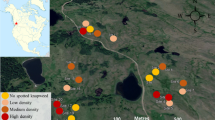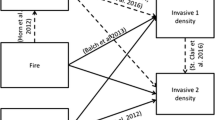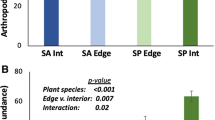Abstract
As primary producers, plants are known to influence higher trophic interactions by initiating food chains. However, as architects, plants may bypass consumers to directly affect predators with important but underappreciated trophic ramifications. Invasion of western North American grasslands by the perennial forb, spotted knapweed (Centaurea maculosa), has fundamentally altered the architecture of native grassland vegetation. Here, I use long-term monitoring, observational studies, and field experiments to document how changes in vegetation architecture have affected native web spider populations and predation rates. Native spiders that use vegetation as web substrates were collectively 38 times more abundant in C. maculosa-invaded grasslands than in uninvaded grasslands. This increase in spider abundance was accompanied by a large shift in web spider community structure, driven primarily by the strong response of Dictyna spiders to C. maculosa invasion. Dictyna densities were 46–74 times higher in C. maculosa-invaded than native grasslands, a pattern that persisted over 6 years of monitoring. C. maculosa also altered Dictyna web building behavior and foraging success. Dictyna webs on C. maculosa were 2.9–4.0 times larger and generated 2.0–2.3 times higher total prey captures than webs on Achillea millefolium, their primary native substrate. Dictyna webs on C. maculosa also captured 4.2 times more large prey items, which are crucial for reproduction. As a result, Dictyna were nearly twice as likely to reproduce on C. maculosa substrates compared to native substrates. The overall outcome of C. maculosa invasion and its transformative effects on vegetation architecture on Dictyna density and web building behavior were to increase Dictyna predation on invertebrate prey ≥89 fold. These results indicate that invasive plants that change the architecture of native vegetation can substantially impact native food webs via nontraditional plant → predator → consumer linkages.




Similar content being viewed by others
References
Abrams P, Menge BA, Mittelbach GG, Spiller D, Yodzis P (1996) The role of indirect effects in food webs. In: Polis GA, Winemiller KO (eds) Food webs: integration of patterns and dynamics. Chapman and Hall, New York, pp 371–395
Adams MR (2000) Choosing hunting sites: web site preferences of the orb weaver spider, Neoscona crucifera, relative to light cues. J Insect Behav 13:299–305
Blackburn TM, Casey P, Duncan RP, Evans KL, Gaston KJ (2004) Avian extinctions and mammalian introductions on oceanic islands. Science 305:1955–1958
Blackledge TA, Wenzel JW (2001) State-determinate foraging decisions and web architecture in the spider Dictyna volucripes (Arameae Dictynidae). Ethol Ecol Evol 13:105–113
Croll DA, Maron JL, Estes JA, Danner EM, Byrd GV (2005) Introduced predators transform subarctic islands from grassland to tundra. Science 307:1959–1961
Crooks JA (2002) Characterizing ecosystem-level consequences of biological invasions: the role of ecosystem engineers. Oikos 97:153–166
Denno RF, Gratton C, Peterson MA, Langellotto GA, Finke DL, Huberty AF (2002) Bottom-up forces mediate natural-enemy impact in a phytophagous insect community. Ecology 83:1443–1458
Gould SJ, Vrba ES (1982) Exaptation; a missing term in the science of form. Paleobiology 8:4–15
Griffin CAM, Thaler JS (2006) Insect predators affect plant resistance via density- and trait-mediated interactions. Ecol Lett 9:333–346
Hairston NG, Smith FE, Slobodkin LB (1960) Community structure, population control, and competition. Am Nat 94:421–425
Henschel JR, Lubin YD (1992) Environmental factors affecting the web and activity of a psammophilous spider in the Namib Desert. J Arid Environ 22:137–189
Heiling AM (1999) Why do nocturnal orb-web spiders (Araneidae) search for light? Behav Ecol Sociobiol 46:43–49
Higgins LE (1990) Variation in foraging investment during the intermolt interval and before egg-laying in the spider Nephila clavipes (Araneae: Araneidae). J Insect Behav 3:773–783
Higgins LE (1992) Developmental changes in barrier web structure under different levels of predation risk in Nephila clavipes (Araneae: Tetragnathidae). J Insect Behav 5:635–655
Hunter MD, Price JS (1992) Playing chutes and ladders: heterogeneity and the relative roles of bottom-up and top-down forces in natural communities. Ecology 73:724–732
Jackson RR (1978) Comparative studies of Dictyna and Mallos (Araneae, Dictynidae): I, social organization and web characteristics. Rev Arachnol 1:133–164
Kreiter NA, Wise DH (2001) Prey availability limits fecundity and influences the movement pattern of female fishing spiders. Oecologia 127:417–424
Langellotto GA, Denno RF (2004) Responses of invertebrate natural enemies to complex-structured habitats: a meta-analytical synthesis. Oecologia 139:1–10
Levine JM, Vila M, D’Antonio CM, Dukes JS, Grigulis K, Lavorel S (2003) Mechanisms underlying the impacts of exotic plant invasions. Proc R Soc 270:775–781
Mack RN, Simberloff D, Lonsdale WM, Evans H, Clout M, Bazzaz FA (2000) Biotic invasions: causes, epidemiology, global consequences, and control. Ecol Appl 10:689–710
Manly B, McDonald L, Thomas D (1993) Resource selection by animals. Chapman and Hall, London
Mielke PW Jr, Kenneth BJ (2001) Permutation methods: a distance function approach. Springer, New York
Mondor EB, Addicott JF (2007) Do exaptations facilitate mutualistic associations between invasive and native species. Biol Invasions 9:623–628
Oksanen L, Fretwell SD, Arruda J, Niemela P (1981) Exploitation ecosystems in gradients of primary productivity. Am Nat 118:240–262
Ortega YK, Pearson DE (2005) Strong versus weak invaders of natural plant communities: distinguishing invasibility from impact. Ecol Appl 15:651–661
Pasquet A, Leborgne R, Lubin Y (1999) Previous foraging success influences web building in the spider Stegodyphus lineatus (Eresidae). Behav Ecol 10:115–121
Pearson DE, Callaway RM (2006) Biological control agents elevate hantavirus by subsidizing mice. Ecol Lett 9:442–449
Polis GA, Strong DR (1996) Food web complexity and community dynamics. Am Nat 147:813–846
Poulsen JR, Osenberg CW, Clark CJ, Levey DJ, Bolker BM (2007) Plants as reef fish: fitting the functional form of seedling recruitment. Am Nat 170:168–183
Pressier EL, Blonick DL, Benard MF (2005) Scared to death? The effects of intimidation and consumption in predator-prey interactions. Ecology 86:501–509
SAS Institute (1999) SAS/STAT user’s guide, version 8. SAS Institute Inc., Cary, NC
Schmitz OJ (2006) Predators have large effects on ecosystem properties by changing plant diversity, not plant biomass. Ecology 87:1432–1437
Schmitz OJ, Krivan V, Ovadia O (2004) Trophic cascades: the primacy of trait-mediated indirect effects. Ecol Lett 7:153–163
Sheley RL, Jacobs JS, Carpinelli MF (1998) Distribution, biology, and management of diffuse knapweed (Centaurea diffusa) and spotted knapweed (Centaurea maculosa). Weed Technol 12:353–362
Sherman PM (1994) The orb-web: an energetic and behavioural estimator of a spider's dynamic foraging and reproductive success. Anim Behav 48:19–34
Story JM, Boggs KW, Good WR, White LJ, Nowierski RM (1995) Cause and extent of predation on Urophora spp. larvae (Diptera: Tephritidae) in spotted knapweed capitula. Environ Entomol 24:1467–1472
Tylianakis JM, Tscharntke T, Lewis OT (2007) Habitat modification alters the structure of tropical host-parasitoid food webs. Nature 445:202–205
Venner S, Bel-Venner MC, Pasquet A, Leborgne R (2003) Body-mass-dependent cost of web-building behavior in an orb weaving spider, Zygiella x-notata. Naturwissenschaften 90:269–272
Venner S, Casas J (2005) Spider web designed for rare but life-saving catches. Proc R Soc Lond 272:1587–1592
Watanabe T (2001) Effects of web design on the prey capture efficiency of the Uloborid spider Octonoba sybotides under abundant and limited prey conditions. Zool Sci 18:585–590
Werner EE, Peacor SD (2003) A review of trait-mediated indirect interactions in ecological communities. Ecology 84:1083–1100
White EM, Wilson JC, Clarke AR (2006) Biotic indirect effects: a neglected concept in invasion biology. Divers Distrib 12:443–455
Wheeler GS, McCaffrey JP, Johnson JB (1990) Developmental biology of Dictyna spp. (Araneae: Dictynidae) in the laboratory and field. Am Midl Nat 123:124–134
Wheeler GS, McCaffrey JP (1989) Egg predation by Catolaccus prob. n. sp. (Hymenoptera, Pteromalidae) on the spider, Dictyna coloradensis (Dictynidae). J Arachnol 17:371–373
Wise DH (1975) Food limitation of the spider Linyphia marginata: experimental field studies. Ecology 56:637–646
Wise DH (1979) Effects of an experimental increase in prey abundance upon the reproductive rates of two orb-weaving spider species (Araneae: Araneidae). Oecologia 41:289–300
Acknowledgments
I thank R. Fletcher, R. Callaway, T. Martin, J. Maron, Y. Ortega, L. Ruggiero, M. Schwartz, and anonymous reviewers for helpful comments. R. King advised on statistical analysis. Spiders were identified by P. Cushing and J. Slowik, Denver Museum of Nature and Science, Denver, CO. C. Crowder, R. Jensen, S. Sears, and J. Smith assisted in data collection. This work was funded by the National Science Foundation (DEB-0236061) and Bitterroot Ecosystem Management Research Project, USDA Forest Service. This research was conduced in compliance with United States laws.
Author information
Authors and Affiliations
Corresponding author
Additional information
Communicated by Sven Bacher.
Rights and permissions
About this article
Cite this article
Pearson, D.E. Invasive plant architecture alters trophic interactions by changing predator abundance and behavior. Oecologia 159, 549–558 (2009). https://doi.org/10.1007/s00442-008-1241-5
Received:
Accepted:
Published:
Issue Date:
DOI: https://doi.org/10.1007/s00442-008-1241-5




